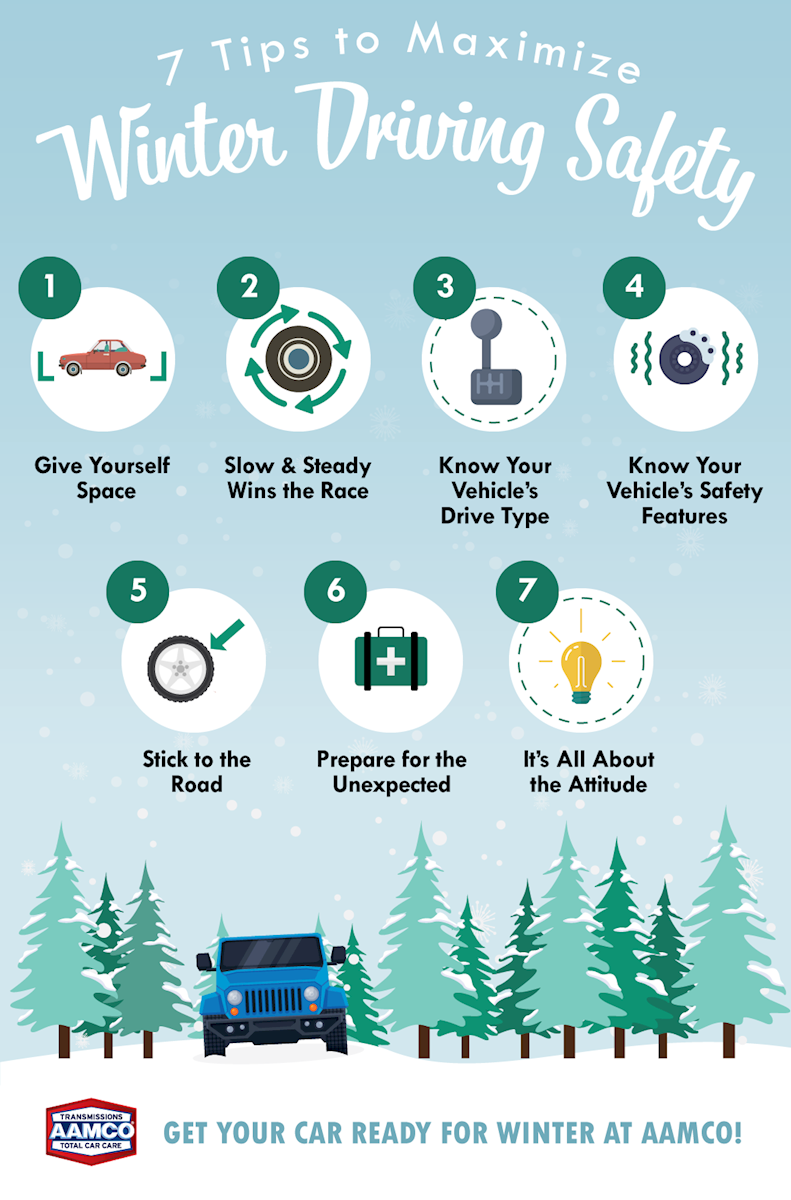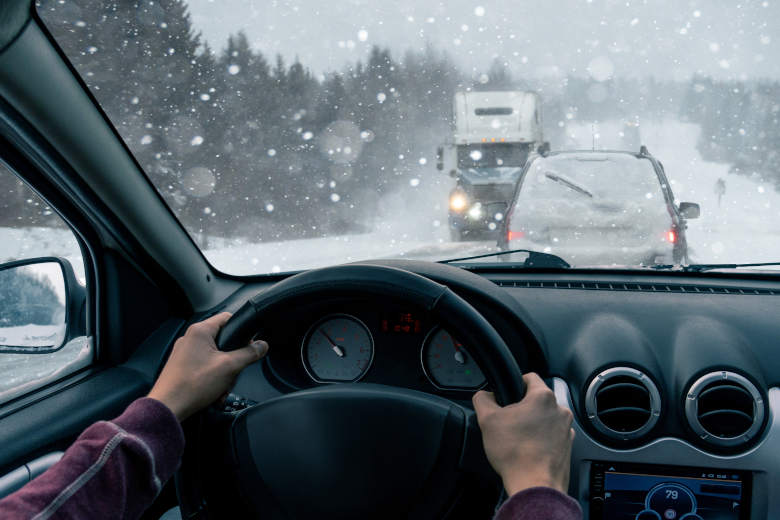7 Ways to Maximize Your Driving Safety This Winter
Stay safe on the road this winter with these winter driving safety tips!
AAMCO | 12/07/2021
Winter is coming quickly, and the potential risks that winter conditions present are many for those who will be out on the road. Unfamiliarity with winter driving can lead to accidents, so being prepared ahead of time can reduce risk.
This article will explain the top seven ways to maximize your winter driving safety and ensure that you make it to your destination without incident.

1. Give Yourself Space
Give yourself plenty of space between your vehicle and those around you. Even if you are driving well below the speed limit, your vehicle may not have as much traction on icy or snow-covered roads compared to other vehicles around you. Ice or snow on the road can make your vehicle even more likely to slide out of control.
To safely navigate these conditions, keep a few extra car lengths between you and the vehicle in front of you to be prepared when vehicles ahead start slowing down or stopping.
Stay alert and avoid using your cruise control in wintery conditions—even if your vehicle is equipped with adaptive cruise control. The sensors, cameras, or radar devices can be adversely affected by the slushy snow when driving and will begin to cling to the sensor modules, leading to the signal being blocked by the slush. When that happens, your collision mitigation system and adaptive cruise control may malfunction, which could be dangerous if you need to act quickly in changing road conditions.
2. Slow & Steady Wins the Race
Another winter driving safety tip is to avoid stopping your vehicle harshly. If roads are slick due to snow, ice, or water, your stopping distance will be much longer than usual.
Try and avoid slamming the brakes, which, if your vehicle is equipped, will activate the antilock brake system. While antilock brake systems help tremendously, a vehicle on a solid sheet of ice will continue to slip and slide with less control than if you apply the brakes more gently. If you need to slow down quickly to stop, apply the brakes slowly and slightly increase pressure as needed. Waiting too long to brake and then applying the brakes too harshly may cause your car to slide on the slippery roads, engage the antilock system, create less control, and potentially lead to an accident.
3. Know Your Vehicle’s Drive Type
Did you know that different vehicle drive types operate differently on snow-covered roads?
Most passenger cars and crossover vehicles are front-wheel drive (FWD). These vehicles have a significant advantage over rear-wheel-drive vehicles when driving in snow and slush. Most of the weight in front-wheel drive vehicles (engine, transmission, and cooling system) is concentrated on the front-drive wheels where traction for accelerating and most important steering occurs. When the steering wheels are the powered wheels, such as in front-wheel drive, all-wheel drive (AWD), and four-wheel drive, you will have more steering and pull through the snow and slush.
Rear-wheel drive vehicle power through the rear wheels where there is very little weight in comparison and the wheels cannot be controlled by the steering wheel. Rear-drive vehicles perform better with dry roads, aggressive driving, and towing better than a rear-drive vehicle but perform poorly in the snow and ice.
If you drive a rear-wheel-drive car, pay extra attention while driving on snow-covered or icy roads to avoid sliding and losing steering control.
All-wheel drive and four-wheel drive vehicles are less susceptible to slipping in winter conditions. The weight, traction, and driven wheels are spread evenly across all four wheels, meaning they can easily pull a vehicle through snowy and icy roads.
4. Know Your Vehicle’s Safety Features
Before hitting the road, make sure you learn where to find and use your vehicle's safety features effectively. Modern cars are designed with unique safety features that can help in winter conditions.
The anti-lock braking system (ABS) helps prevent the wheels from locking up when you brake hard. Locking of the wheels is one of the most significant factors in causing a skid, and an ABS helps prevent this from happening by quickly pulsing the slipping wheel to allow for shorter stopping distances.
Another helpful feature is electronic traction control, one of the essential safety features, which uses algorithms to detect individual wheel speeds and help keep your vehicle stable.
5. Stick to the Road
The quality and health of your tires and suspension should be at the top of your winter driving safety list. Here are the ways to figure out if your tires are winter-ready by checking these main items:
-
Choose the Right Tire
Choosing the correct tire has a lot to do with your local climate or the climate of the area you may be traveling to.
Winter Tires
For winter climates that experience snow and frigid temperatures that dip below 40° F (4° C), it’s highly recommended to switch out your current tires with winter tires. Winter tires are engineered to perform better in inclement climates where drivers experience a wide range of wintry weather such as snow, sleet, rain, and ice. They have compounds that stay flexible at low temperatures for better road grip. More aggressive and angular treads patterns readily push out icy rain and snow to boost traction and handling during nasty weather. The three-peak mountain snowflake (3PMSF) symbol embossed on the tires indicates that the tire meets the required criteria in snow testing to ensure it can perform under extreme snow conditions.
All-season Tires
All-season tires are a solid choice for climates with mild, shorter winters that rarely approach freezing conditions, experience very little snow, or do not regularly experience inclement weather.
All-weather Tires
These tires are a hybrid between all-season tires and winter tires and save drivers in colder climates from changing out and storing their tires each year during the fall and spring seasons. However, there are trade-offs to convenience, such as a shorter tread life and tread life warranties. And while these tires also have a three-peak mountain snowflake (3PMSF) symbol embossed on them, it’s worth mentioning that dedicated winter tires will consistently outperform all-weather tires in snowy conditions.
-
Tire Tread
No matter what type of tires you choose for your winter driving, your tire tread depth is an essential factor in the safety and health of your tire.
Tire treads are designed to ensure one thing: keeping your tires in contact with the road. The more connection your tires have with the road, the more traction and control you have over your vehicle, reducing the possibility of slipping on icy or snowy roads.
Vehicles with good tread allow slush and ice to be pushed out from under the tire to maintain tire contact with the road. They are also less susceptible to punctures and sudden blowouts.
Even acceptable treads in warm, dry conditions can have reduced performance in winter conditions, as tested and noted by Consumer Reports. Check your treads regularly through seasonal servicing of your vehicle and talk with a professional about appropriate tires for your local climate.
-
Shocks, Struts, and Suspension.
While tires are designed to enable maximum traction on pavement, your shocks, springs, struts, and suspension parts ensure the tires are firmly planted to the pavement. Bad suspension parts will allow the tires to hop, skip and jump across the pavement reducing the tire to pavement contact.
Each time you change your oil, have your professional look at tire tread wear patterns and worn suspension parts for those telltale signs.
-
Maintain Proper Tire Pressure
Your vehicle will have the best handling with properly inflated tires—from accelerating to steering—so don’t overlook this crucial aspect of tire maintenance.
Lower air temperature equates to lower tire pressure in the colder months, so be on alert to check your tire pressure more often, especially if temperatures fluctuate by 10 degrees or more.
Low tire pressure ups the chances of potholes giving your vehicle a flat tire and sudden blowouts on the highway due to overheating.
6. Prepare for the Unexpected
Even with the best winter vehicle maintenance and preparation, breakdowns and accidents can occur. If your vehicle gets stuck or breaks down while traveling, or you are involved in an accident, an emergency kit is imperative to have stocked and ready in times of need.
An emergency kit should include items such as:
- fully charged cell phone
- first aid kit
- jumper cables
- flares, reflective triangles, or road cones
- foldable shovel
- sand/salt/gravel/kitty litter
- ice scraper and snow brush
- extra washer fluid
- flashlight
- gloves
- blankets and extra layers of clothes
- non-perishable items such as water and energy bars
Before each trip, note who is in your vehicle most often, what they may need, and consider adding more items if you are traveling long distances for the holidays.
7. It’s All About the Attitude
Want to know your vehicle’s biggest safety feature? You. Your driving behaviors can affect others on the road, no matter how young or old you are. The best way to protect yourself and those around you this winter is by driving with an attitude geared toward patience and safety.
Impatience and road rage can contribute to dangerous situations and serious accidents. If you are angry or frustrated, take a break from driving before getting behind the wheel again. If you or someone you love exhibits Intermittent Explosive Disorder (IED), characterized by explosive outbursts of anger, don’t allow them to drive and seek professional help for their safety and others.
Not used to winter driving and nervous about traveling? In areas of the U.S. with more intense winters, winter driving classes are commonly available. The best way to handle winter driving is through practice and experience.

Visit Your Auto Technician and Protect Yourself This Winter
One of the best ways to avoid accidents is by visiting an AAMCO Professional Technician to learn about winter vehicle maintenance. Plan for the worst and hope for the best to help bring everyone home safely this winter season.
Contact Us!
Our expert technicians can help you remain safe and on the road this season, whether it’s performing winter miracles on a damaged transmission or giving the best winter car care advice. Give us a call today!


